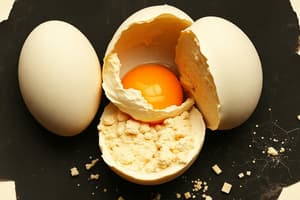Podcast
Questions and Answers
What elements are proteins made of?
What elements are proteins made of?
Carbon, hydrogen, oxygen, & nitrogen. Sometimes sulfur.
Define amino acids.
Define amino acids.
Nitrogen containing chemical compounds of which protein is composed.
Define polypeptides.
Define polypeptides.
10 or more amino acids bonded together.
What are the 3 main functions of protein in the body?
What are the 3 main functions of protein in the body?
Give an example of contractile proteins.
Give an example of contractile proteins.
Give an example of fibrous proteins.
Give an example of fibrous proteins.
Describe the ways that protein works to regulate body functions.
Describe the ways that protein works to regulate body functions.
How many calories are in 1 gram of protein?
How many calories are in 1 gram of protein?
How many amino acids are there?
How many amino acids are there?
How many essential amino acids are there?
How many essential amino acids are there?
Which amino acids are only essential during childhood?
Which amino acids are only essential during childhood?
What is a complete protein? Give examples.
What is a complete protein? Give examples.
What is an incomplete protein? Give examples.
What is an incomplete protein? Give examples.
Define bioavailability.
Define bioavailability.
What are meat analogues? When would you recommend them?
What are meat analogues? When would you recommend them?
What are some examples of meat analogues?
What are some examples of meat analogues?
Define complementation and give examples.
Define complementation and give examples.
Be able to calculate protein needs.
Be able to calculate protein needs.
Describe the negative health effects of excess protein.
Describe the negative health effects of excess protein.
Discuss excess protein intake and weight management.
Discuss excess protein intake and weight management.
Define nitrogen balance.
Define nitrogen balance.
What is positive nitrogen balance?
What is positive nitrogen balance?
What is negative nitrogen balance?
What is negative nitrogen balance?
Define catabolism, its relationship to nitrogen balance, and give examples of when a person would be in this state.
Define catabolism, its relationship to nitrogen balance, and give examples of when a person would be in this state.
Define anabolism, its relationship to nitrogen balance, and give examples of when a person would be in this state.
Define anabolism, its relationship to nitrogen balance, and give examples of when a person would be in this state.
Define and describe protein deficiency.
Define and describe protein deficiency.
What is marasmus?
What is marasmus?
What is kwashiorkor?
What is kwashiorkor?
Flashcards are hidden until you start studying
Study Notes
Protein Composition and Functions
- Proteins are composed of carbon, hydrogen, oxygen, nitrogen, and sometimes sulfur.
- Amino acids are nitrogen-containing compounds that form proteins.
- Polypeptides consist of 10 or more bonded amino acids.
- Proteins serve three main functions: building and repairing tissues, regulating body functions, and providing energy.
Types of Proteins
- Contractile proteins are found in muscles.
- Fibrous proteins are present in bones, hair, nails, and skin.
Protein Regulation and Requirements
- Proteins regulate metabolism and digestion through enzymes and hormones, and maintain fluid/electrolyte balance via albumin.
- One gram of protein provides 4 calories.
- There are 20 amino acids, including 10 essential ones that the body cannot synthesize.
- Arginine and histidine are essential only during childhood.
Protein Completeness
- Complete proteins contain all 10 essential amino acids; examples include eggs and dairy.
- Incomplete proteins lack one or more essential amino acids; common in vegan diets.
Nutritional Concepts
- Bioavailability refers to the ease with which nutrients can be absorbed and utilized by the body.
- Meat analogues are alternatives made from soy protein to replace meat, recommended for strict vegetarians.
- Examples of meat analogues include tofu, textured plant protein, and veggie burgers.
Protein Complementation and Needs
- Complementation involves combining incomplete proteins to provide all essential amino acids, e.g., corn with beans or bread with peanut butter.
- Calculate protein needs by dividing body weight by 2.2 kg, then multiplying kg by 0.8 to get grams of protein.
Health Implications
- Excess protein can lead to health issues such as heart disease, colon cancer, and increased kidney stress.
- Protein intake should not exceed 15-20% of daily caloric intake.
Nitrogen Balance
- Nitrogen balance occurs when nitrogen intake equals nitrogen excreted.
- Positive nitrogen balance happens when intake exceeds excretion, typically during growth or recovery.
- Negative nitrogen balance occurs when nitrogen loss exceeds intake, often due to illness or injury.
Protein Metabolism
- Catabolism, indicating negative nitrogen balance, happens during periods such as fever, injury, or surgery.
- Anabolism, indicative of positive nitrogen balance, occurs during pregnancy, muscle building, or recovery from trauma.
Protein Deficiency and Malnutrition
- Protein deficiency leads to muscle wasting and may cause albumin deficiency resulting in edema and various health issues.
- At-risk populations include the elderly, impoverished individuals, and those with disabilities.
- Marasmus is a severe malnutrition condition characterized by insufficient calories and protein, resulting in dry hair and wrinkled skin without edema.
- Kwashiorkor results from a lack of protein-containing foods despite adequate calorie intake, marked by abdominal edema and skin lesions.
Studying That Suits You
Use AI to generate personalized quizzes and flashcards to suit your learning preferences.




